Travellers' Tales :: The Lost Kingdom of Guge
THE LOST KINGDOM OF GUGE
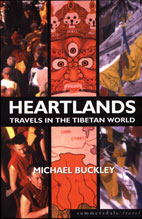
the following story appears in the anthology Travelers' Tales Tibet, and is excerpted from Heartlands: Travels in the Tibetan World, copyright Michael Buckley, 2002
In Thailand, I once went to Ripley's Motion Master Theatre—an innovative kind of theatre that utilises, apart from big-screen cinemascope, the added sense of motion. Your seat is rigged up with high-tech hydraulic gear: you're strapped in with a full lap-and-shoulder seatbelt. You watch a RoboCop motorcycle chase or a high-speed spaceship pursuit: synchronised with the action, you are hurled to the left, right, upward, downward, sideways—hydraulically, of course—as you hang on for dear life with hand grips. The show lasted seven minutes—the expensive technology couldn't be sustained any longer.
The Landcruiser to west Tibet was just like that except there were no handgrips, no seatbelts—and the show went on for five days. Five days of being banged around from tea-kettle to breakfast time to get to a town called Zanda. Our target was the site of the ancient kingdom of Guge (pronounced Goo-gay)—with ruins scattered in valleys around Zanda. It required a stack of permits—town permits, military permits, cultural relics bureau permits, you name it. We had enough paperwork to open an origami salon. But eventually we edged closer to our target.
Perhaps 'edged' is not the word I'm looking for here. There was virtually no suspension in our Landcruiser—the shocks were shot. If you were in the back seat and the driver hit a rut, you would fly up and bang your head on the roof—and then be thumped down hard on your ass and get the stuffing knocked out of you. There were hardly any springs left in the seats, either. And you'd get showered in dust—take dust baths. At times it got so bad you had to wear a silk scarf or something over your face to filter the dust out of your breathing apparatus. And you might—as I did—take to wearing a wool hat to soften the blow on the interior roof.
Actually, it was more comfortable in the front cabin of the truck. We'd
hired two vehicles—a Landcruiser and a Dongfeng truck. The latter acted
as a tow truck should the Landcruiser ride too deep on a stream-crossing—which
at one point ours did. Coming round a bend in the truck, I got to witness
the spectacle of four bedraggled foreigners struggling to get out of
a river—away from the Landcruiser, which had water swirling over the
tyres. The driver, Speedy, had seriously misjudged the depth of a stream-crossing.
Fortunately, the Landcruiser started up first time after being hauled
out (I've heard of other Landcruisers that never started again).
Our team of backpackers clubbed together in Lhasa to split expenses
on this epic 4WD tour of far western Tibet—a round-trip of some 2000
miles, taking 25 days to complete. Our main targets were the ruins of
the Guge Kingdom and the hike around sacred Mount Kailash.
It was a motley crew of riders: ages varied considerably. Pema was only 21. She was given her Tibetan name by her Swiss father, who used to work in Nepal—and who encouraged her to come back and see the Himalayas. At the other end of the spectrum was Diane, from Belgium, in her forties—a late-comer to trekking. Her role-model was Alexandra David-Néel—the famed French explorer who travelled extensively in her fifties, carrying a revolver to protect herself. Like her mentor, Diane was obstinate, moody and cantankerous by turns—and bossy. Others in the group were Verena, from Austria; Kozo, a young Japanese; and Barbara, a Filipino photographer based in Hong Kong.
The Tibetan crew consisted of Doko, the young guide; 'Speedy', the Landcruiser driver; and Tenzin, the Khampa truck driver who seemed to have a woman in every major town along the route. Speedy was inseparable from his Chicago Bulls cap: the NBA is big in Amdo, where Speedy was from. Speedy was so nicknamed because of his terrifying shortcuts—he liked driving straight down sand dunes, instead of using the switchbacks provided. Moody Doko would cheer him on, while the rest of us gritted our teeth. It was much more relaxing in the cabin of the truck—if only because Tenzin loved to sing, and had a great voice, and an endless repertoire of nomad folk-songs. Which he was keen to expand on: this Tibetan bard hounded us to sing in English or in French.
The hardship of the trip was counter-balanced by the stunning scenery en route. We planned to take the north route to Ali, and from there dip south to Guge and Kailash, and return to Lhasa on the south route. The initial route took us on a great loop through Chang Thang—the vast desert and grassland region of northern Tibet. We passed nights in no-name inns at horrible, polluted truck-stop towns en route—Tsochen, Dongco, Gertse and Tsaka. But otherwise, it was pristine terrain—and we spotted Tibet's rare wildlife—wild asses, black-necked cranes, the odd antelope. We'd see groups of four or five kiang (wild asses)—not the great herds that used to roam these high grasslands. The once-abundant wildlife has been machine-gunned into oblivion by Chinese settlers and military. For food—and for sport.
Speaking of food: the back of the truck was stacked with barrels of gasoline. Gasoline depots are few and far between out this way—and more designed for the Chinese military. Besides, any gas out west is way more expensive than it is in Lhasa. Over and around the gas barrels were burlap bags and cardboard boxes packed with food—potatoes, carrots, bottled water, 761 army-ration biscuits, and other essentials that we'd salvaged at Lhasa's main market. Trouble was, the two elements—food and gasoline—got mixed together a few days' ride out of Lhasa. A gas barrel sprang a leak somewhere, but the driver couldn't determine which barrel that was—and didn't care to empty the entire cargo to find out.
So we had potatoes that reeked of gas.
Which was quite dangerous because the method of cooking was a miniature
flamethrower—the same device used to heat up the engine when frozen
(the Tibetan version of anti-freeze). You'd aim this gadget side-on
at an elevated pot, and a great flame would shoot out and nuke the food.
The tough-as-nails Tibetan crew turned their nose up at our gas-scented
food. They had their own hessian bags, filled with dried carcass of
goat, or rock-hard yak-cheese—things like that. At picnic stops, they'd
exhume the carcass of the day, and resume work on it—carving off great
hunks of dried meat with their knives. A bit like beef jerky in texture.
That's about all I want to say about the food. It makes my stomach churn
if I write any more.
At the PSB office in Ali, Doko got bored with permit procedures, which were taking forever. I was scribbling some notes, and he looked over my shoulder.
'So how's the book?' he asked.
I could've strangled Doko right then and there, but fortunately the PSB
woman didn't tune into the conversation. She was too preoccupied with
the problem of Belgium. Belgium was one of the nations listed for our
permit. But what exactly was Belgium? She's never heard of Belgium.
We sorted this one out by indicating Belgium was sandwiched between
England and France.
'How many books have you written?' piped
up Doko again.
'Listen Doko, I don't write any fucking
books, okay?' I shot back.
'Okay!' he laughed. It was a knowing laugh
because he had recognised my face in the author credit page of the Lonely
Planet guide to China.
We had no desire to stay in Ali, but permits
had to be checked, validated, re-checked, and stamped again. Ali is
an architect's nightmare—concrete blockhouses, kiosks, garbage strewn
all over. And at night, tuneless wailing from karaoke bars. This is
Karaokeville—full of Chinese army officers, and girls in private karaoke
booths—in the middle of the desert, in the middle of nowhere, in west
Tibet.
So you're driving along one day—and suddenly you forget where you are, or where you are going, or what you're doing, or why. Ever experienced that feeling? It happened to me in the cabin of the truck—I'd been dozing off, in some distant dreamworld, and woke up when the engine started wheezing and spluttering. I wearily opened my eyes—and my jaw dropped. There was snow everywhere. There were great peaks all around, with yaks cavorting in the background. I thought I must be hallucinating from the altitude: my eyes grew wider as we crested a pass that registered 17,400 feet on my altimeter. How high? asked my fellow trucker. Um, fairly high, I hedged, gasping from the thin air. We were driving over an entire frigging mountain range! And if my sources were correct (putting Zanda at 12,000 feet), that meant an astonishing drop of 5400 feet on the other side of the pass.
It was indeed a long drop down. At dusk, we levelled out—we hit a canyon, followed a riverbed. This turned out to be a phantasmagoric canyon: a sorcerer's creation of mud and clay, sculpted into surreal shapes. And it went on and on...for over an hour. It was thoroughly entrancing. 'It is very shapeful,' said Doko. 'The rocks have shapes like chortens or castles.' He pointed out a huge rock resembling a seated Buddha, and another that looked like an old man with a wispy beard. The imagination could run riot here. Phantoms appeared everywhere—warriors, kings, queens, monks. They all seemed to jump out of the clay—silent sentinels guarding the approach route.
In one day I'd absorbed enough new landscape to last the brain several months to process. Finally, in the distance, rays of light lit up Zanda, on an outcrop. Set in barren desert terrain, Zanda is unmistakeable—it is an oasis with poplar trees. The Sutlej River lay in our path: it required another six miles of detouring to gain a bridge across the river, and at one corner, Speedy almost lost it on a piece of loose gravel. He could have sent us plunging into an abyss, but at the last minute, the Landcruiser corrected itself, and we all breathed easier. Speedy, of course, would not acknowledge that he'd almost killed us all. He laughed it all off. But you could tell it was a nervous laugh.
That said, the trip to Guge was a hell of a lot easier than it used to be. The earliest Western
accounts of this hidden valley—the Guge Kingdom—were by Jesuits, who'd
heard rumours of a lost Christian-like sect. In March 1624, two Portuguese
Jesuits—Father Marques and Father Andrade—set out from India disguised
as Hindu pilgrims. They were on foot, with pack animals, crossing passes
that were probably 18,000 feet or more. At times, they sank into snow
up to their chests. They complained of frozen feet, of blindness, and
of suffocating 'poisonous vapours'—probably the first Western accounts
of altitude sickness, by the first Europeans known to enter Tibet. Their
round trip from India took over eight months.
Arriving in Tsaparang, the centre of the Guge Kingdom, the Jesuits were
surprised to be warmly received. They puzzled over how people in such
a barren wasteland could survive—all the food had to be imported from
fertile valleys that were two weeks away on foot. But part of the jigsaw
fell into place when they witnessed a caravan of 200 Chinese traders
passing through, carrying silk and porcelain—Tsaparang was an important
trading centre. And flocks of goats and sheep kept the royal court supplied
for basics.
Father Andrade wrote of being invited by the king to Toling Gompa, to celebrate a special occasion. There were over 2000 monks in attendance. The Jesuits found that temple rituals bore superficial similarities to Christian—monks in robes spent hours chanting—but drinking from human skull-cap vessels and playing trumpets fashioned from human thigh-bones were definitely a little different. Andrade was the first to publish to the world the sacred chanting mantra Om Mani Padme Hum, but could not determine its meaning (which experts still debate today). Andrade returned to Tsaparang in 1625 with fellow missionaries: the Jesuits eventually built a small church in Tsaparang. Andrade died in India in 1634—poisoned by a colleague who evidently didn't share his enthusiasm for the Inquisition.
But back to the religion of Guge. It was actually quite special. In the 9th century, Buddhism was snuffed out in central Tibet by King Langdarma, a staunch supporter of the rival Bon faith. Upon the assassination of Langdarma, Tibet was broken up into lay and monastic pockets of influence. The Guge Kingdom became an enclave that was vital for the survival of Buddhism. The King of Guge at that time promoted cultural exchanges with Indian Buddhists: Guge became an important centre of Buddhist studies—a reputation that grew with the arrival of 11th-century scholar Atisha, from India.
The Guge Kingdom probably lasted over 500 years. In several sources, it has been described as a cultural Mecca—a citadel greater than Lhasa at the time. But around 1650 (some sources give 1630), Tsaparang was suddenly abandoned. It is said that the King of Guge angered his lamas by favouring Father Andrade and that factional fighting ensued—and that the kingdom tore itself apart.
Other sources claim that a two-year siege by Ladakhis led to the fall of Guge. The reason: the king rejected a bride who happened to be the sister of the King of Ladakh—who was supremely insulted. Although well-entrenched in his citadel, the King of Guge decided to cut a deal and surrender, according to one source—but this backfired because the treacherous Ladakhis had no intention of honouring the deal. The king and the royal family were carried off into exile, and his followers were reduced to slavery (another source claims the king and his courtiers were killed on the spot). Whatever the case, Guge fell into obscurity—and ruins. Not only that: successive waves of invaders went to great lengths to wipe out all traces of the kings of Guge, making it near-impossible to recount the history of the place.
AS I TRACE A MANDALIC MURAL in the Red Temple at Tsaparang with my flashlight, I am convinced of one thing. This must have been a brilliant culture. We'd arrived by Landcruiser, on the short commute from Zanda—only 16 miles distant, but it seemed to be light years away. To enter the temples at Tsaparang is to venture into a different world—to be in the presence of master artisans. The murals resonate their power and that of their patrons: they are mute testimony to the brilliance of the Guge Kingdom. They speak of a culture that is at once alien yet highly imaginative—with bold design and vibrant use of colour.
Eerily illuminated by flashlight are huge, beautiful Tara frescoes—white, green, wrathful manifestations—and other icons from the Tibetan Buddhist pantheon painted on the walls. And fantastic creatures—half-beast, half-human. And then the flashlight picks up some detail that turns out to be a stunning miniature—an entire work of art in itself. The murals are breathtaking. And offer some clues about dress and customs in the long-lost kingdom of Guge. Because not everything portrayed is mythical. Really bringing Guge to life are frescoes of courtiers welcoming an important envoy, arriving by donkey. Another fresco shows a high lama giving teachings. Moving along to the Yamantaka Chapel—named after resident tantric deity, Dorje Jigje—the walls bear a quite different kind of ancient mural: sumptuous paintings of Tibetan tantric deities tangled in yabyum embraces with their consorts.
The murals date from the 16th and 17th centuries—before the fall of Guge. We will probably never know the identity of the artists at Guge—in the tradition of Tibetan Buddhism, this kind of art springs from an anonymous well. We do know that the king of Guge was wealthy enough to be able to import artisans from regions like Kashmir. But while the style may be Kashmiri, it is also distinctly Tibetan. Visiting in 1933, Italian scholar Guiseppe Tucci noted 'an art peculiar to Guge, distinctive in itself and independent of the art movements in other parts of Tibet.'
Tucci was among the handful of privileged Westerners to see the site in its pre-Chinese days. He left a detailed description of the artwork in its more intact state—particularly the statuary. Guge seems to have escaped plundering by Western treasure seekers and museum collectors, but not so the Chinese. In the mid-1960s, Red Guards ran amok and trashed the temples of Guge—smashing precious statuary in their wake—but miraculously, the murals were left largely unscathed. The temples suffered some water damage, but since this is a desert area, things are kept freeze-dried, naturally. It's an odd juxtaposition of clay ruins, destroyed statuary, but intact murals on the temple walls.
Having nearly destroyed the place, the Chinese now see fit to be overly protective of it. The Chinese appear to have a monopoly on Guge Kingdom photography. In addition to the reams of paperwork we have already acquired, we discover that if you want to photograph interiors at Guge, you need a special permit from Beijing. A little inconvenient, at this point, to arrange that—and it is most likely exorbitant and time-consuming to procure.
So we employ a short-cut: Doko and Tenzin will keep the Tibetan caretaker busy with a flask of chang, while Speedy brings along all the keys to the chapels. There is nobody else around except us—nobody will notice the odd camera-taking episode. A second photography problem: there is hardly any light to work with. The chapels are dim—even when electric light switches are found, the murals are dim. Fortunately for me, Barbara has a whole bag full of photo-gear, and I borrow a flash-unit from her—hoping it will communicate with my camera and synchronise to take the right exposures.
We are still at the lower extremities of Tsaparang: the site is a great peak made of clay. Winding upward from the lower temples, we walk past a series of 'cave-condos' fashioned from clay, and small fort-like structures with watchtowers poking up. To withstand siege, Tsaparang citadel developed an ingenious system of tunnelling to internal springs deep in the mountain. Other tunnels serve as escape routes. We could not see these, but to reach the top of Tsaparang citadel, you must scramble through a long spiralling tunnel that is bored out of clay, with steps cut out. This tunnel could be completely sealed in times of siege.
At the uppermost reaches—crowning this mountain of clay—is Tsaparang Dzong, with various structures thought to serve as palaces for the king, queen and high officials. The finest artwork at Tsaparang is to be found in a tiny building here, thought to be the gonkhang, and probably the site of initiation rites. Centrepiece of the gonkhang is a large 3-D mandala that now lies in ruins—smashed to pieces by Red Guards. However, exquisite miniature murals still grace the walls: depicted are rows of voluptuous dancing dakinis, who personify the wisdom of enlightenment. Apart from their elaborate jewellery, they are naked—representing the uninhibited dance of awareness. In Tibetan lore, dakinis live in hidden heavenly paradises and, like personal guardian angels, appear mysteriously to practitioners when they face great trouble—to provide motivation when the chips are down. Below the dakinis are gory scenes of disembodiment from hell realms. The chapel is dedicated to protector deity Demchok, shown in murals with his consort Dorje Phagmo. Together they symbolize the union of bliss and emptiness.
The view from the top of the citadel is phenomenal: on this crystal-clear day, dramatic desert landscapes stretch to the far horizon. 'Desolate' and 'barren' are two adjectives that spring to mind—but somehow seem sadly inadequate to convey the immensity of space, and the stillness that envelops it. Standing there, some lines from poet Percy Shelley popped into my head—lines I'd learned by heart long ago, about an Egyptian king:
'My name is Ozymandias, king of kings:
Look upon my works, ye mighty, and despair!'
Nothing beside remains: round the decay
Of that colossal wreck, boundless and bare,
The lone and level sands stretch far away.
Back in our base in Zanda, there were more glorious murals to be viewed at Toling Gompa—but at a price. The monk-caretaker who held the keys to the different chapels was a highly-skilled extortionist. Every step of the way—every new door—required more cash donations, and it got to the point where some among us just said no (or used stronger language). But I persisted, because at this point the money wasn't going to stymie my thirst for such original artwork.
Scattered through the valleys around Zanda are numerous meditation caves—some lined with murals. More are waiting to be discovered. Incredibly, I found that the concept of a citadel topping a mountain of clay was not limited to Tsaparang. Just outside Zanda is a similarly sited citadel, with access through a huge tunnel carved into the side of the clay mountain. This is the weirdest hiking I've ever done—once through the tunnel, you reach an upper plateau, with scores of former cave-dwellings, and dangerous crevasses of clay. And majestic views of the valley where Zanda lies.
From this aerial perch, Zanda seems like a fantastic, mythical place. It has that touch of Shangri-La—a remote valley, an oasis of poplar trees, an ancient ruined temple, and snowy peaks in the distance. But my idea of Shangri-La is not a Chinese army base and Chinese restaurants—which, essentially, is what Zanda is. Although there is a Tibetan quarter near the monastery, Zanda is not a Tibetan town anymore: it's a Chinese garrison town—little more than a main drag lined with concrete blockhouses. Most large towns in Tibet have an obvious military presence, but it is more pronounced here because of an on-going territorial dispute between India and China. Zanda lies close to the border with Ladakh.
In the final hours in Zanda—before our Landcruiser headed south—I went about some mundane chores. One of these was to visit the tiny post office. I bought some postcards of the Guge ruins in Lhasa and wanted to post them from Zanda (where no postcards were on sale, naturally). I always do this from really remote places, just to see if the post actually works. 'Feiji!' I said to the woman at the post office hopefully, slapping my right hand off the palm of my left—imitating a plane taking off. At this, she let out a high-pitched cackle. Airmail! Airmail from Zanda! She rushed to tell her co-workers. Pretty soon there were guffaws coming from all directions. Airmail!

POSTCARDS FROM THE GUGE KINGDOM
(these photos are not in the book)
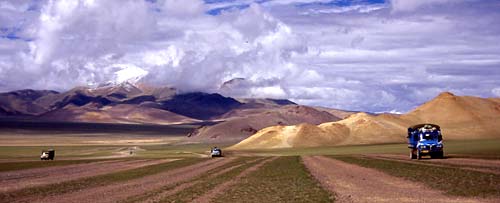
choose your own road on the grasslands of west Tibet
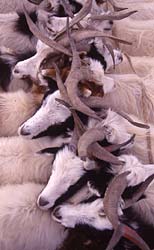
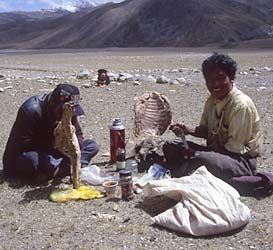
LEFT: locking horns: goats tied by the horns for milking
RIGHT: lunchtime—dried mutton and yak-butter tea

canyon on the way to Guge Kingdom
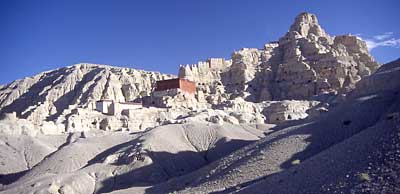
the ruins of Tsaparang
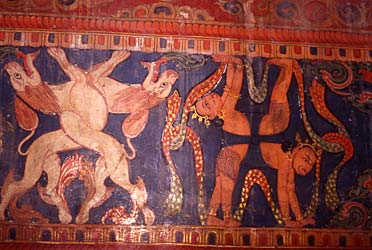
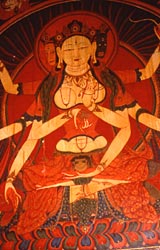
frescos from Tsaparang
